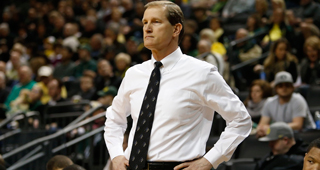Click here for Part 1 including the projected conference standings.
Arizona St.: Everyone knows about last year’s super-frosh PG Jahii Carson, but the player who amuses me most is stretch-4 Jonathan Gilling. Despite great rebounding numbers and post-play on defense, he lived on the perimeter on offense. Gilling took four times as many three pointers as two pointers, and made 84 threes on the year.
And that will be useful because the biggest question market for Arizona St. next year is outside shooting. There just aren’t many attractive candidates at the off-guard position. Last year’s Hawaii transfer Bo Barnes wasn’t able to contribute much. And I’m not that much more excited about Michigan St. transfer Brandon Kearney. Kearney rarely took outside shots at Michigan St. and made them even less often. Freshman Chance Murray might eventually be the answer, but his recruiting rank suggests he may not be ready this year.
Arizona St. has more depth at forward with Valparaiso transfer Richie Edwards and JUCO transfer Sai Tummala joining the team. But the lack of perimeter shooting will hurt.
Oregon: Here is something you may not know. Oregon wasn’t a very good offense team last year. They got out in transition and so their games weren’t stuck in the 50’s, but they were much less skilled offensively than you might think.
The reason Oregon had its best season under Dana Altman was that Altman’s defense was the best of his career. Somehow, after back-to-back years of lackluster defense, the Ducks had an elite defensive unit. A large part of that was the late addition of Arsalan Kazemi. He personally ate up so many defensive rebounds that Oregon’s defensive rebounding improved from 162nd to 27th nationally. To say Kazemi will be missed is an understatement. Expect Oregon to be competitive defensively this year, but more in line with Altman’s historical performance.
Thus to return to the tournament the team will have to be better on offense. And while Oregon adds some nice pieces, they also lose four of their five most efficient offensive players (EJ Singler, Carlos Emory, Tony Woods, and Kazemi).
UNLV transfer Mike Moser can replace some of that production. Elite recruit Jordan Bell can replace some of it. Top 10 JUCO Elgin Cook is another nice piece. And Dominic Artis should be able to chip in by avoiding injury this year.
But it will take a special season for all those players to replace what was lost. In expectation, Oregon looks a little worse on offense, and meaningfully worse on defense, which should make them a fringe bubble team. My model currently has them 60th nationally.
But Altman has proven he can win with a whole new group of players, and if anyone can prove my model wrong, I would not count him out.
Oregon St.: With Oregon St. returning nearly 70 percent of its minutes, you might think this will be a veteran squad next year. But many of those minutes went to players like Challe Barton and Jarmal Reid who do not appear to be Pac-12 caliber players. Because of the need to look for better options, the team is going to have to give a lot of time to new lineup pieces again. The team has three Pac-12 quality starters in Roberto Nelson, Devon Collier, and Eric Moreland, but the rest of the lineup is relatively weak.
Washington St.: Brock Motum, the team’s best player is gone, and there aren’t any players who can replace his star quality. This is the only team in the Pac-12 without any Top 100 athletes. Teams can win without elite talent if the coach is good at developing players, but after four seasons Ken Bone has proven to be below average in that regard. If Bone doesn’t develop a few hidden gems this season, he will likely be replaced.
Assuming last year’s partial qualifier Que Johnson has his academics in order now, he could help. And transfers Brett Kingma (ORtg of 97 at Oregon), Jordan Railey (ORtgs of 85 and 68 at Iowa St.), and Danny Lawhorn (46th ranked JUCO) will try to upgrade the offense too. I don’t want to make it sound hopeless, but Bone absolutely must break the trend if he wants to keep his job.
USC: Omar Oraby is the only returning player with an ORtg over 100. Worse yet, the retuning players that couldn’t score last year had a quality point-guard feeding them the ball in scoring position. Now Jio Fontan is gone and the team’s PG prospects are thin. Will the highly inefficient P’Shon Howard become eligible immediately? Will the team turn to unranked freshman recruit Julian Jacobs or Kahlil Dukes? Will former walk-on Chass Bryan, who played major PG minutes last year get the call? None of them is a particularly attractive option.
This also explains why UNLV transfer Katin Reinhardt was willing to sign with USC this off-season. Reinhardt left UNLV because he wants to play the PG position. And Reinhardt is likely going to have to sit out this season. But USC’s options at the PG spot are so under-whelming that Reinhardt is confident he will be the starter next season.
It is possible that a less structured, run-and-gun, dunk-city offense help the team score more effectively. I certainly trust that kind of system more in the Pac-12 than a league like the Big 10 where you run into coaches like Bo Ryan on a regular basis. But give Andy Enfield some time. Wait until Reinhardt and fellow transfer Darion Clark become eligible next year. Until then, this could be the worst offense in the Pac-12 again.
Utah: I expect Jordan Loveridge to become a household name as a sophomore. He is a former top 100 recruit and he was an aggressive and surprisingly efficient given his large role as a freshman. But the Utes bring in seven new players including three junior college transfers. Expect more growing pains.



